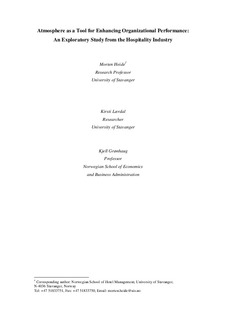| dc.contributor.author | Heide, Morten | |
| dc.contributor.author | Lærdal, Kirsti Margrethe | |
| dc.contributor.author | Grønhaug, Kjell | |
| dc.date.accessioned | 2015-05-28T06:13:54Z | |
| dc.date.accessioned | 2015-05-28T07:44:43Z | |
| dc.date.available | 2015-05-28T06:13:54Z | |
| dc.date.available | 2015-05-28T07:44:43Z | |
| dc.date.issued | 2009 | |
| dc.identifier.citation | Morten Heide, Kirsti Lærdal, Kjell Grønhaug, (2009) "Atmosphere as a tool for enhancing organizational performance: An exploratory study from the hospitality industry", European Journal of Marketing, Vol. 43 Iss: 3/4, pp.305 - 319 | nb_NO |
| dc.identifier.issn | 1758-7123 | |
| dc.identifier.uri | http://hdl.handle.net/11250/284146 | |
| dc.description | -"This article is © Emerald Group Publishing and permission has been granted for this version to appear here. Emerald does not grant permission for this article to be further copied/distributed or hosted elsewhere without the express permission from Emerald Group Publishing Limited." - | nb_NO |
| dc.description.abstract | Purpose
– The concept of atmosphere is often considered vague and difficult to capture, which hampers adequate feedback on atmospheric investments. This paper aims to report a systematic effort to capture the concept and enhancing factors, making adequate feedback for efforts to improve atmosphere possible.
Design/methodology/approach
– Owing to limited a priori insights, an exploratory, discovery‐oriented approach was chosen. Semi‐structured interviews, supplemented with secondary data, were conducted to gain insight into how managers and design experts think and cope to improve the atmosphere of establishments. The hospitality industry was selected as empirical context.
Findings
– Investments to improve the atmosphere of establishments can bring significant benefits. However, the positive effects are associated with uncertainty and consequently the risks can be substantial. However, such risks were only recognized by hospitality managers, not by design experts.
Research limitations/implications
– This study is a first step and was therefore restricted to the supply side of the industry. For practical purposes, the empirical setting was limited to a single country.
Practical implications
– Care should be taken not to overkill with atmosphere and thereby lose focus on the main service/product offering. Hospitality managers and owners need to be assertive to get the right balance between aesthetic elements and operational requirements because design experts tend to neglect the latter.
Originality/value
– Given the considerable interest in, and consequently the presumed value of, atmosphere as an intangible asset, this paper provides important insights into an area where there is genuine need for empirical research. | nb_NO |
| dc.language.iso | eng | nb_NO |
| dc.publisher | Emerald Group Publishing Limited | nb_NO |
| dc.title | Atmosphere as a tool of enhancing organizational performance: An exploratory study from the hospitality industry | nb_NO |
| dc.title.alternative | Atmosphere as a tool of enchancing organizational performance: An exploratory study from the hospitality industry | |
| dc.type | Journal article | nb_NO |
| dc.type | Peer reviewed | nb_NO |
| dc.date.updated | 2015-05-28T06:13:54Z | |
| dc.source.pagenumber | 305-319 | nb_NO |
| dc.source.volume | 43 | nb_NO |
| dc.source.journal | European Journal of Marketing | nb_NO |
| dc.source.issue | 3-4 | nb_NO |
| dc.identifier.doi | http://dx.doi.org/10.1108/03090560910935442 | |
| dc.identifier.cristin | 730383 | |
